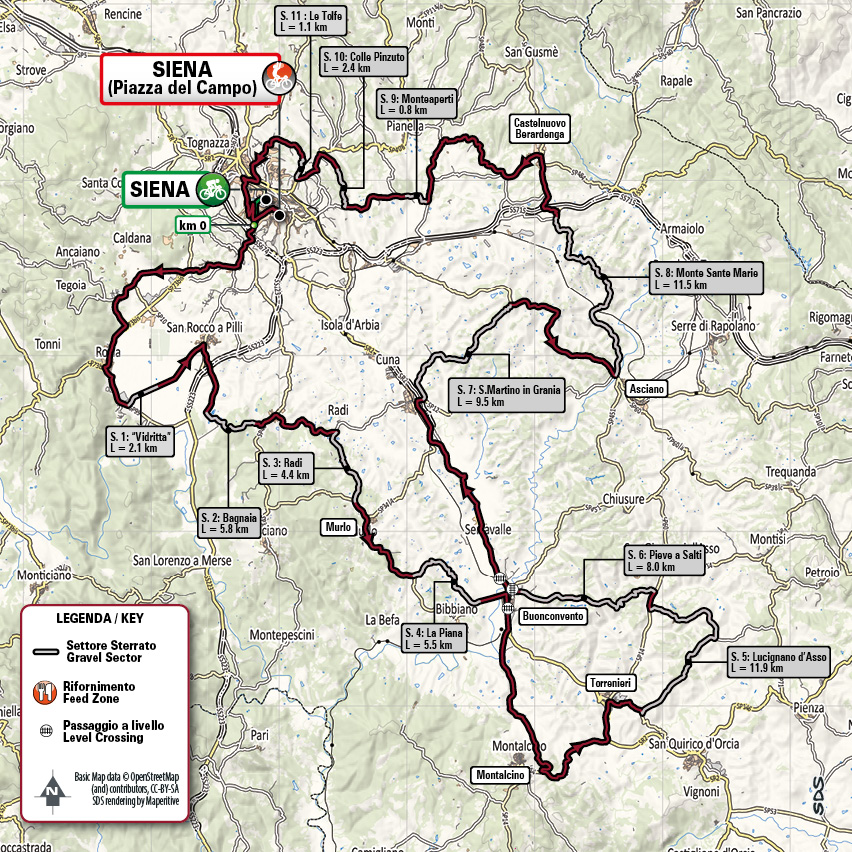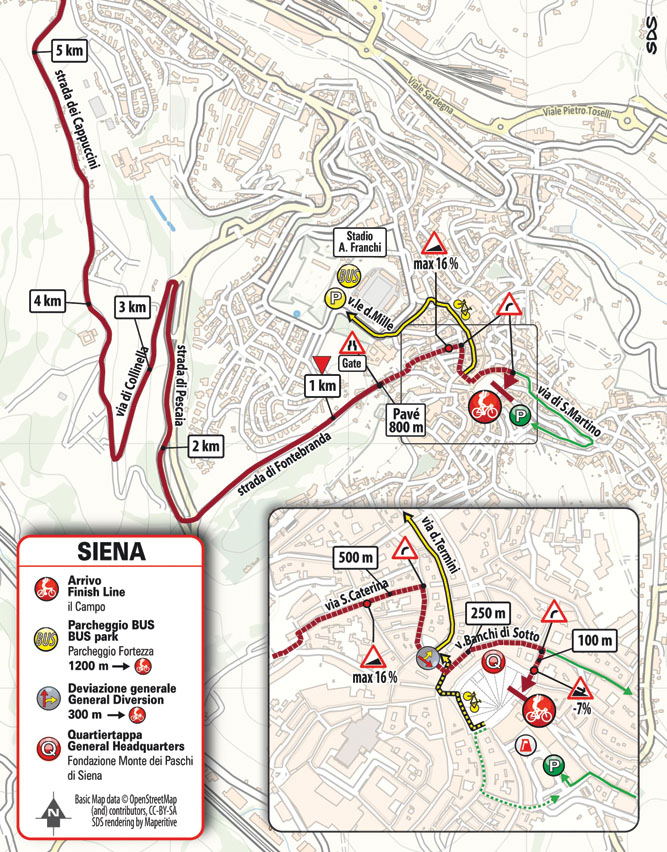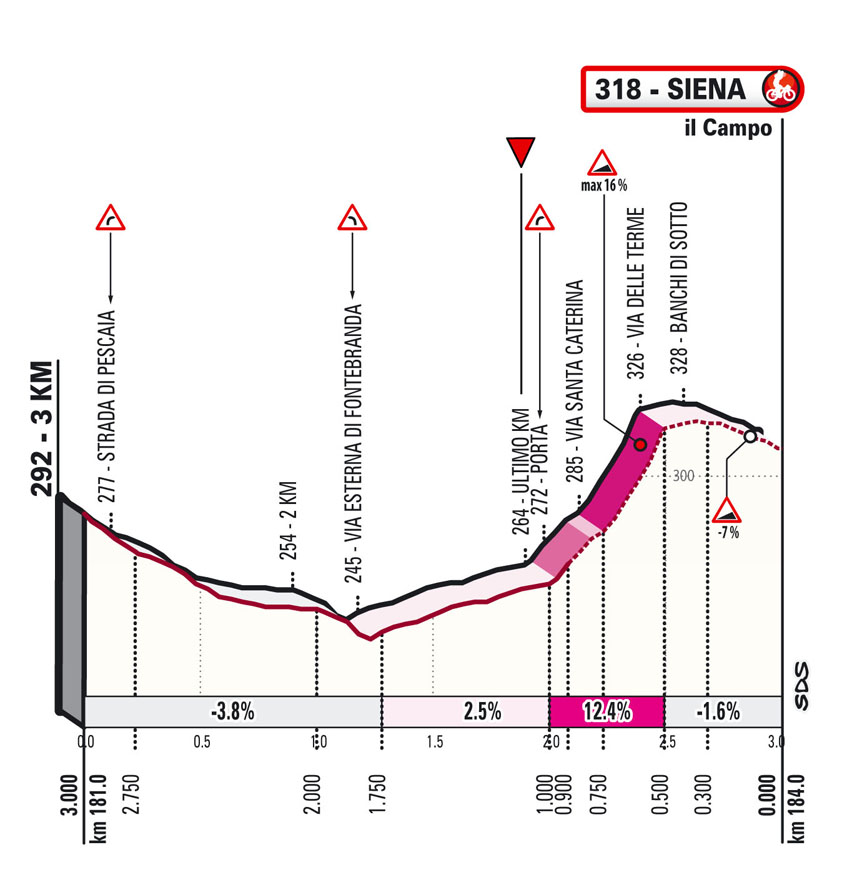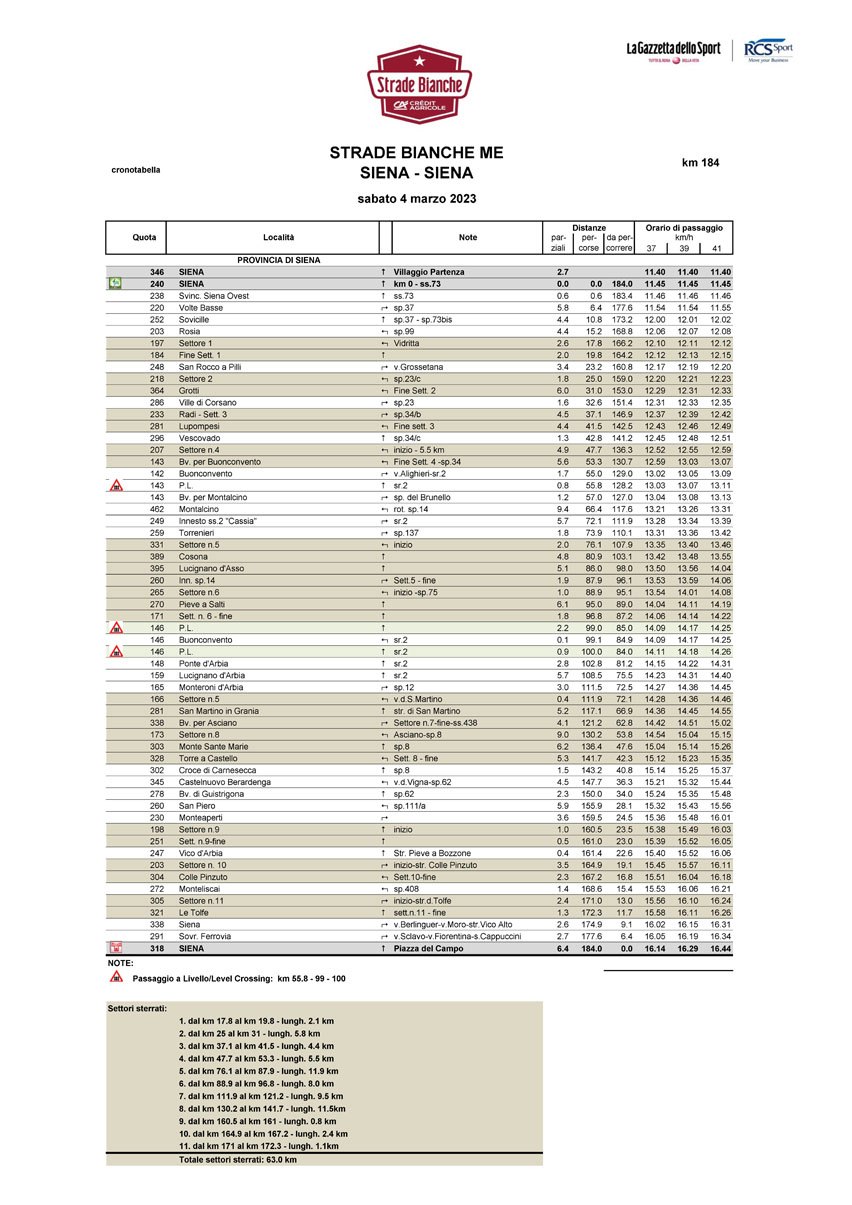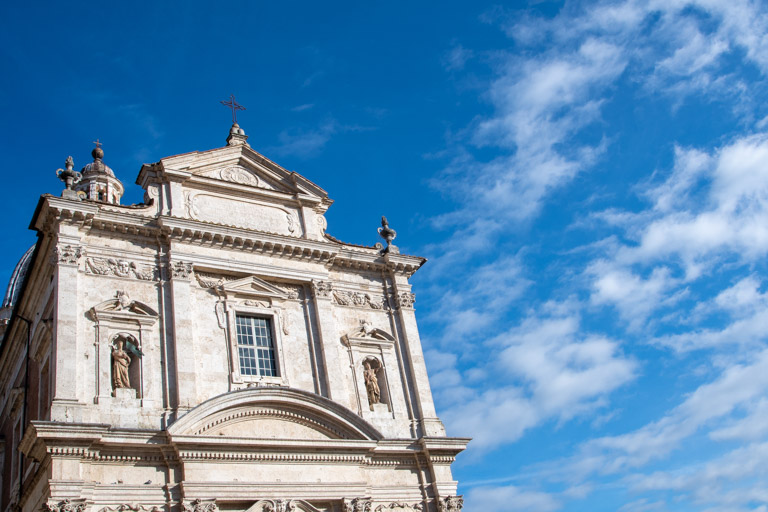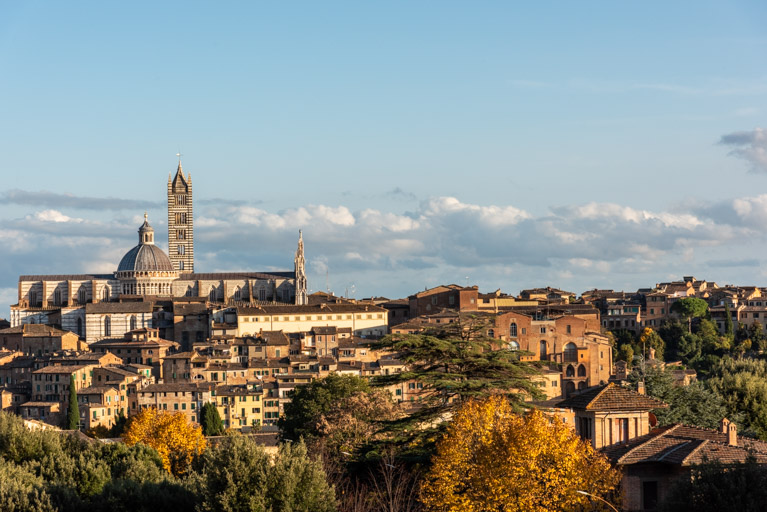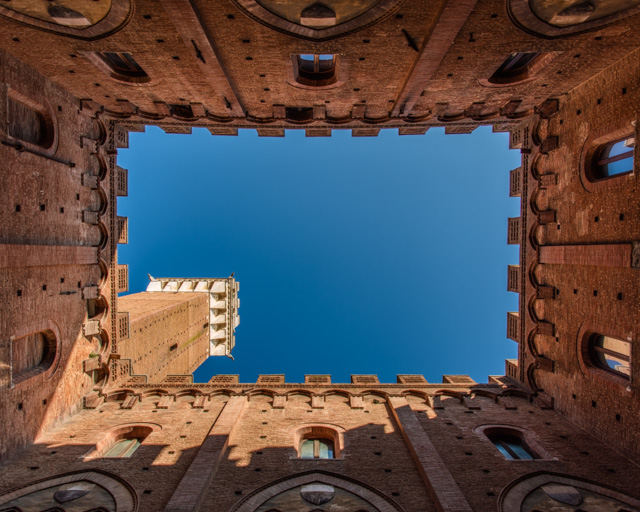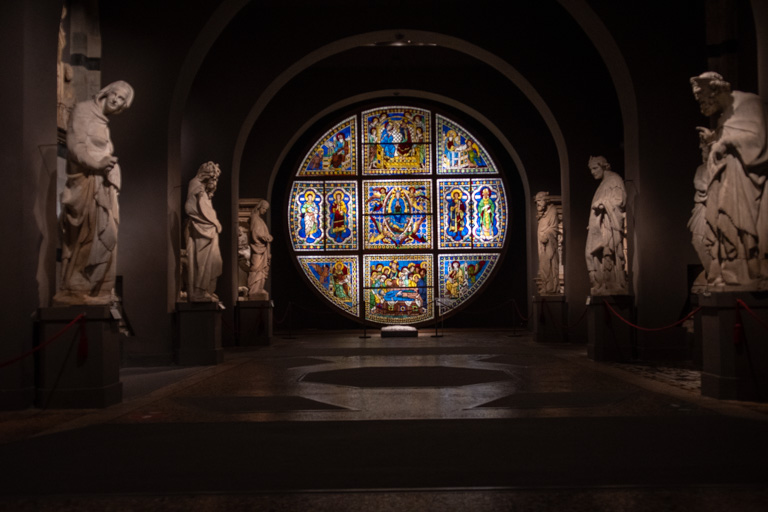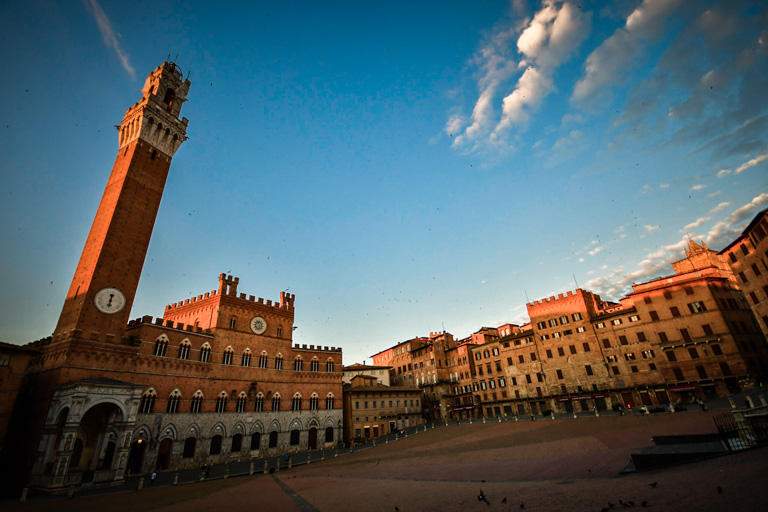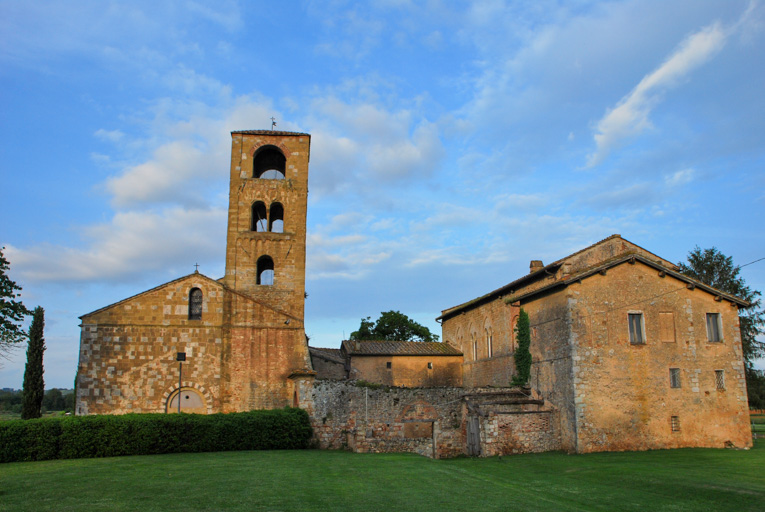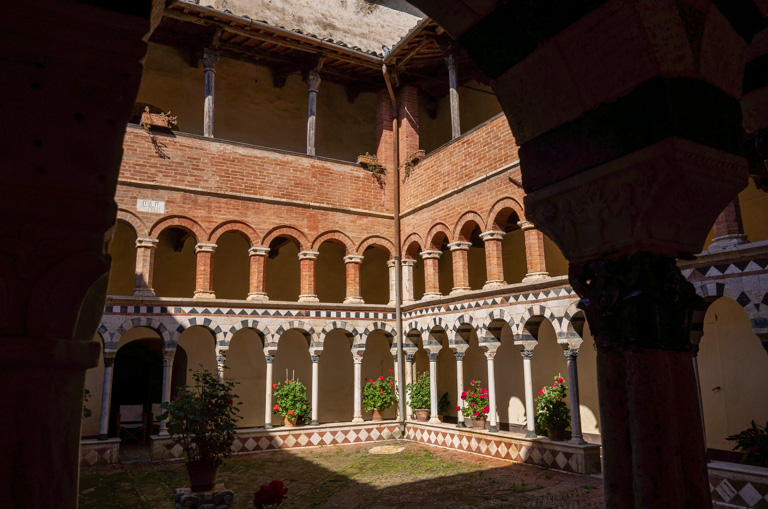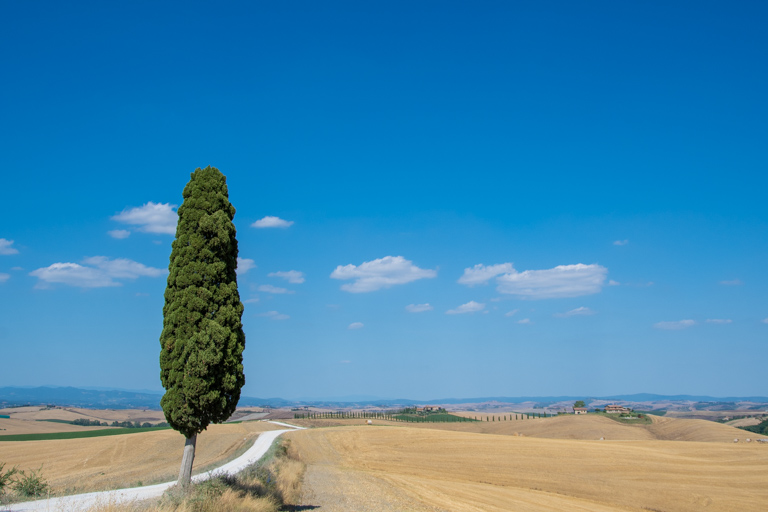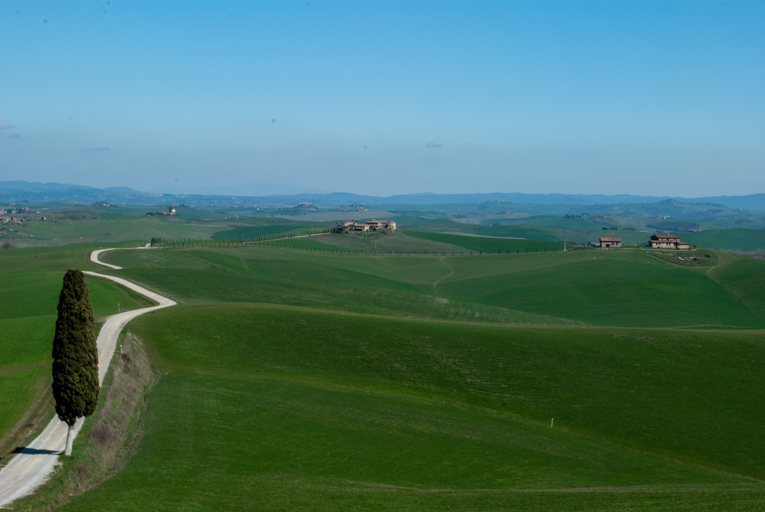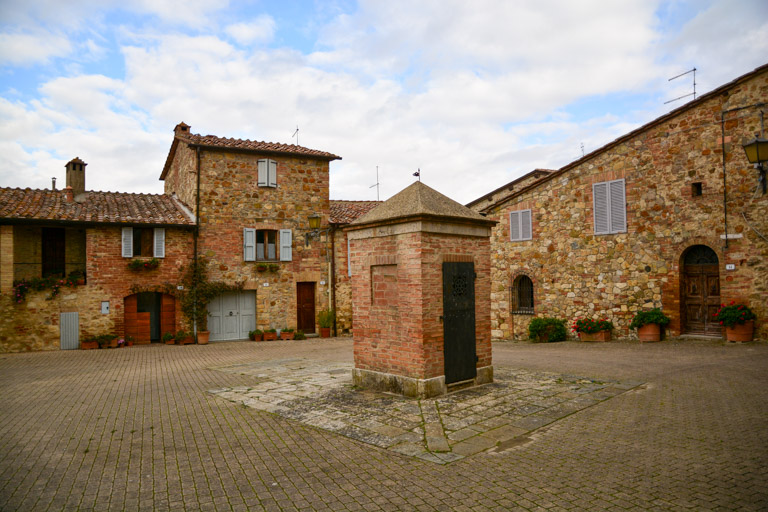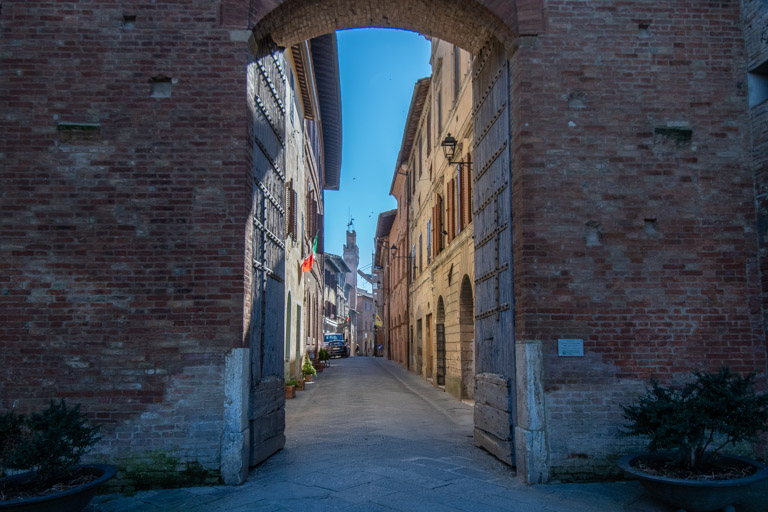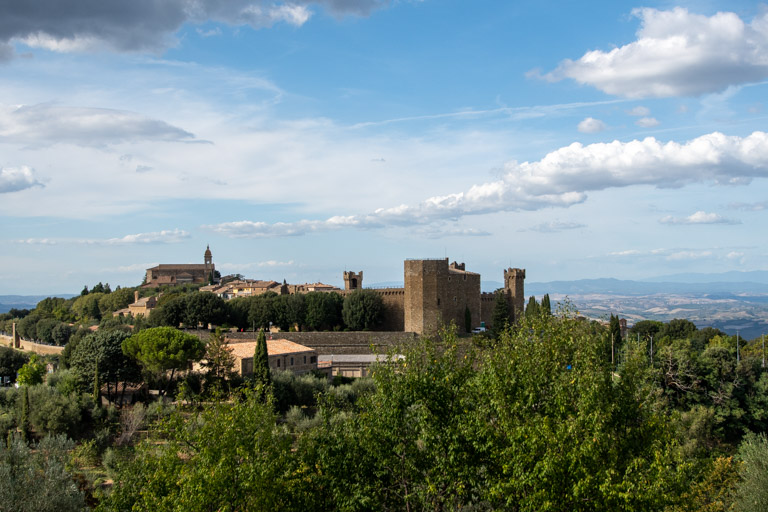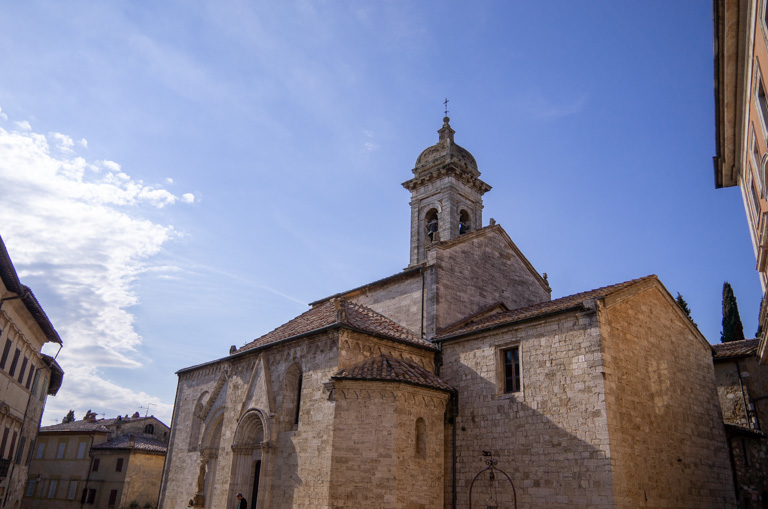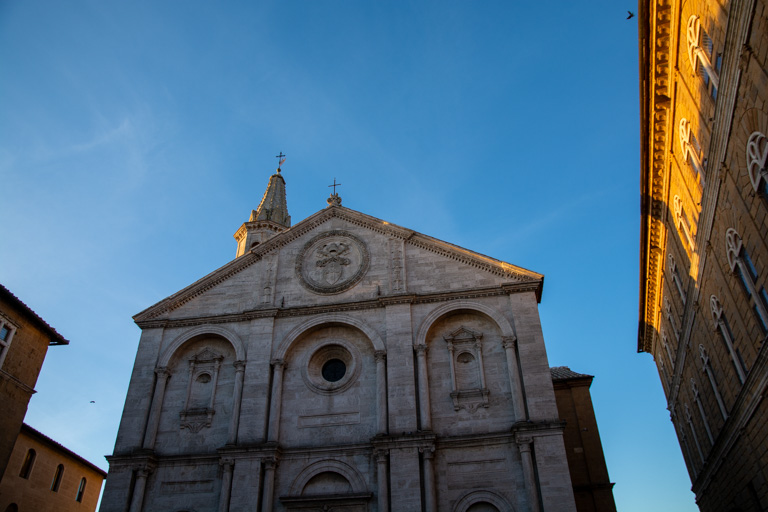profile
map
technical info
It’s a twisty and undulating course, with no long climbs but punchy hills, most significantly on the unpaved sections of the route. There are roughly 63km of gravel roads, across 11 sectors, eight of which are shared with the Women Elite course.
Starting from the Stadium/Medicean Fortress area of Siena, the initial undulating kilometers are on asphalt before reaching the 2.1km-long gravel Sector 1 at km 18, which is perfectly straight and slightly downhill. After a few kilometers, the riders then face Sector 2 (5.8km), the first real challenge, with a short descent followed by a long climb with sections of over 10% gradient. The course then goes through Radi, where gravel Sector 3 starts (4.4km long; the second part of what was gravel Sector 1 in the race’s first edition) shortly followed by Sector 4 – named “La Piana” – and one of the race’s classic gravel sectors (5.5km in length, and featured in the course ever since the first edition) with no significant gradient, leading to Buonconvento.
A few kilometers later, the second climb of the day begins: the Montalcino (4km at 5%). Following Torrenieri the riders face Sectors 5 (11.9km) and 6 (8km) with only 1km of tarmac in between. Both are hard, hilly and very punchy, with many challenging bends, climbs and descents. After the second passage through Buonconvento, the riders will reach the feed station, positioned in the area of Ponte d’Arbia. Soon the route reaches Monteroni d’Arbia, which marks the beginning of Sector 7 of San Martino in Grania (9.5km) in the middle of the Crete Senesi. It’s a long sector with continuous ups and downs in the first part, ending up with a twisting climb before meeting the tarmac again.
In Ponte del Garbo (Asciano) gravel Sector 8 begins. At 11.5km it’s the hardest of the race, mostly uphill and characterised by tough hills, the most important being those close to Monte Sante Marie, with steep gradients on both climbs and descents over short distances. After Castelnuovo Berardenga there’s a very short, flat section of gravel (300m) before facing, after Monteaperti, Sector 9 – it’s only 800m long, but greets the riders with a double-digit gradient ramp before they rejoin the tarmac in Vico d’Arbia and then a paved road through Pieve a Bozzone.
Next comes the penultimate section of gravel (Sector 10, 2.4km) on the climb toward Colle Pinzuto, with gradients of up to 15%. After a few kilometers, the riders then face the last gravel section (Sector 11, 1.1km) which features a sequence of demanding descents followed by a very punchy climb (with a maximum gradient of 18%) that ends at the Tolfe. From there, only 12km separate the riders from the finish in Piazza del Campo, Siena.
Final Kilometers
The demanding final kilometers, with gradients up to 16%, approach the city of Siena along broad, straight sections of road, connected by sweeping curves, first descents and slight climbs. At 2km from the finish line, the route joins Via Esterna di Fontebranda; here the gradient touches 9%.
With 900m to go to the finish line, the race route passes beneath Fontebranda Gate where the road surface becomes paving slabs. The gradient then exceeds 10% until 500m from the finish, reaching its steepest gradient of 16% along Via Santa Caterina. A sharp right-hand turn leads to Via delle Terme, and then Via Banchi di Sotto. With 300m to go, the road continues to climb slightly then, 150m from the line, a right turn leads into Via Rinaldini. The route enters the Piazza del Campo just 70m from the finish line. The final 30m descends at a gradient of 7% to the finish line itself, which is flat.
start / finish
final kilometres
itinerary timetable
tourist info
Host city:
Siena
Siena
Siena is nestled among the gentle Tuscan hills. Here, it feels as if time has stopped at the 13th century, when the city’s artistic and architectural heritage started to develop, earning Siena its endless renown. It has been on the UNESCO World Heritage List since 1995, owing to its well-preserved mediaeval structure. The main square, Piazza del Campo, is the mandatory starting point to describe the city. The square has a unique shell shape, and gently slopes towards the centre. This is where the famous Palio takes place: every year, in summer, the different Contrade (city quarters) challenge each other in a compelling horse race. All around are a number of monumental buildings, such as Palazzo Sansedoni and Palazzo Pubblico. Towering over the square is the majestic Torre del Mangia, built in the 1340s. Soaring an impressive 102 metres, it is just as tall as the Duomo belfry, to symbolize the balance between worldly and divine power. But there is more to Siena than just Piazza del Campo, including little streets and alleys teeming with little shops and craft stores where you can buy local handmade products or taste the famous cantucci cookies with a glass of Vin Santo. Throughout the narrow alleys, all the way to the wide Piazza del Campo, you can actually feel the real atmosphere of this city – contemporary yet ancient, monumental yet lively, all of which makes it the perfect setting for the start and finish of this iconic bicycle race. (Ph. Credits Antonio Cinotti)
Sovicille
Lying at the southern slopes of the Montagnola Senese, Sovicille is the Tuscan town with the highest concentration of parish churches, abbeys, castles and villas. Valuable examples of the Romanesque style are the Pieve (parish church) of Ponte allo Spino, Ponte della Pia, and the polychrome cloister of the Abbey of Torri. The fairy-tale castle of Celsa and the grandiose Villa di Cetinale (a former possession of the Chigi family) are bound to leave you breathless with their charm and grandeur. (Ph. Credits Antonio Cinotti)
Monteroni d'Arbia
The Via Francigena runs through the entire municipal territory of Monteroni d’Arbia. Many historical landmarks can be found along this ancient route, including the castle of Lucignano d’Arbia and its parish church, which already existed back in 913 a.D., and the famous Grancia di Cuna, a majestic fortified farm built in 1314. (Ph. Credits Antonio Cinotti)
Murlo
Murlo is a little, well-preserved mediaeval village lying at the heart of an unspoilt territory. Its inhabitants were found to be the actual descendants of the ancient Etruscans. The village is best known for being home to a unique Etruscan settlement on the surrounding hills: a large princely building surrounded by craft workshops, one of the major findings about this civilisation. (Ph. Credits Antonio Cinotti)
Buonconvento
The village of Buonconvento is still surrounded by the ancient defensive walls, and has retained its original mediaeval appearance. Major landmarks include the belfry (Torre Civica) of the ancient government palace, Palazzo Podestarile. However, wandering the streets of the town is just as evocative, especially in September, when the famous Sagra della Valdarbia brings the love for good food, music, arts and literature together. (Ph. Credits Antonio Cinotti)
Montalcino
Founded by the Etruscans and best known for Brunello wine, Montalcino is a lovely village lying at the mouth of Val d’Orcia. Major landmarks include the 14th century pentagonal fortress with its towers, and a museum housing a collection of late mediaeval art. The Abbey of Sant’Antimo, one of the major examples of Tuscan Romanesque architecture, is a must-see. (Ph. Credits Antonio Cinotti)
San Quirico d’Orcia
San Quirico d’Orcia lies at the heart of a World Heritage landscape that embodies the essence of the Val d’Orcia. The impressive Horti Leonini, created around 1580, are the most popular attraction. Major architectural landmarks also include the Osenna collegiate or parish church (dating back to the 12th-13th century). Bagno Vignoni, the only hamlet in San Quirico d’Orcia, is home to Piazza delle Sorgenti, a large, rectangular 16th century hot spring which is definitely worth a visit. (Ph. Credits Antonio Cinotti)
Pienza
A UNESCO World Heritage site since 1996, Pienza was hometown to Pope Pius II, who considered it the “ideal” city of the Renaissance. The projects that were conceived at that time are a significant example of the rational urban architecture of the Italian Renaissance, although not all of them were actually implemented. Taking a walk through Piazza Pio II to visit Palazzo Piccolomini and the cathedral is something you cannot miss. (Ph. Credits Antonio Cinotti)
Asciano
Lying at the heart of the Crete Senesi, and surrounded by breath-taking landscapes, Asciano is an ancient Etruscan village that experienced its greatest splendour during the Middle Ages. The old town centre is a treasure trove of art and history, where traditions and legends merge inseparably. (Ph. Credits Antonio Cinotti)
Castelnuovo Berardenga
Castelnuovo Berardenga is the southernmost town of the Chianti area. Its territory is a unique combination of gentle slopes and uneven hills, guarded by castles, churches and fortifications, with cypress-lined alleys leading the way. In 1260, the battle of Monteaperti, won by Siena and its allies against Florence, marked the beginning of the Ghibelline rule over Tuscany, and invested Siena with a political and economical predominant role, both in Italy and in Europe. (Ph. Credits Antonio Cinotti)
Siena
Siena
Siena is nestled among the gentle Tuscan hills. Here, it feels as if time has stopped at the 13th century, when the city’s artistic and architectural heritage started to develop, earning Siena its endless renown. It has been on the UNESCO World Heritage List since 1995, owing to its well-preserved mediaeval structure. The main square, Piazza del Campo, is the mandatory starting point to describe the city. The square has a unique shell shape, and gently slopes towards the centre. This is where the famous Palio takes place: every year, in summer, the different Contrade (city quarters) challenge each other in a compelling horse race. All around are a number of monumental buildings, such as Palazzo Sansedoni and Palazzo Pubblico. Towering over the square is the majestic Torre del Mangia, built in the 1340s. Soaring an impressive 102 metres, it is just as tall as the Duomo belfry, to symbolize the balance between worldly and divine power. But there is more to Siena than just Piazza del Campo, including little streets and alleys teeming with little shops and craft stores where you can buy local handmade products or taste the famous cantucci cookies with a glass of Vin Santo. Throughout the narrow alleys, all the way to the wide Piazza del Campo, you can actually feel the real atmosphere of this city – contemporary yet ancient, monumental yet lively, all of which makes it the perfect setting for the start and finish of this iconic bicycle race.
Sovicille
Lying at the southern slopes of the Montagnola Senese, Sovicille is the Tuscan town with the highest concentration of parish churches, abbeys, castles and villas. Valuable examples of the Romanesque style are the Pieve (parish church) of Ponte allo Spino, Ponte della Pia, and the polychrome cloister of the Abbey of Torri. The fairy-tale castle of Celsa and the grandiose Villa di Cetinale (a former possession of the Chigi family) are bound to leave you breathless with their charm and grandeur. (Ph. Credits Antonio Cinotti)
Monteroni d’Arbia
The Via Francigena runs through the entire municipal territory of Monteroni d’Arbia. Many historical landmarks can be found along this ancient route, including the castle of Lucignano d’Arbia and its parish church, which already existed back in 913 a.D., and the famous Grancia di Cuna, a majestic fortified farm built in 1314. (Ph. Credits Antonio Cinotti)
Murlo
Murlo is a little, well-preserved mediaeval village lying at the heart of an unspoilt territory. Its inhabitants were found to be the actual descendants of the ancient Etruscans. The village is best known for being home to a unique Etruscan settlement on the surrounding hills: a large princely building surrounded by craft workshops, one of the major findings about this civilisation. (Ph. Credits Antonio Cinotti)
Buonconvento
The village of Buonconvento is still surrounded by the ancient defensive walls, and has retained its original mediaeval appearance. Major landmarks include the belfry (Torre Civica) of the ancient government palace, Palazzo Podestarile. However, wandering the streets of the town is just as evocative, especially in September, when the famous Sagra della Valdarbia brings the love for good food, music, arts and literature together. (Ph. Credits Antonio Cinotti)
Montalcino
Founded by the Etruscans and best known for Brunello wine, Montalcino is a lovely village lying at the mouth of Val d’Orcia. Major landmarks include the 14th century pentagonal fortress with its towers, and a museum housing a collection of late mediaeval art. The Abbey of Sant’Antimo, one of the major examples of Tuscan Romanesque architecture, is a must-see. (Ph. Credits Antonio Cinotti)
San Quirico d’Orcia
San Quirico d’Orcia lies at the heart of a World Heritage landscape that embodies the essence of the Val d’Orcia. The impressive Horti Leonini, created around 1580, are the most popular attraction. Major architectural landmarks also include the Osenna collegiate or parish church (dating back to the 12th-13th century). Bagno Vignoni, the only hamlet in San Quirico d’Orcia, is home to Piazza delle Sorgenti, a large, rectangular 16th century hot spring which is definitely worth a visit. (Ph. Credits Antonio Cinotti)
Pienza
A UNESCO World Heritage site since 1996, Pienza was hometown to Pope Pius II, who considered it the “ideal” city of the Renaissance. The projects that were conceived at that time are a significant example of the rational urban architecture of the Italian Renaissance, although not all of them were actually implemented. Taking a walk through Piazza Pio II to visit Palazzo Piccolomini and the cathedral is something you cannot miss. (Ph. Credits Antonio Cinotti)
Asciano
Lying at the heart of the Crete Senesi, and surrounded by breath-taking landscapes, Asciano is an ancient Etruscan village that experienced its greatest splendour during the Middle Ages. The old town centre is a treasure trove of art and history, where traditions and legends merge inseparably. (Ph. Credits Antonio Cinotti)
Castelnuovo Berardenga
Castelnuovo Berardenga is the southernmost town of the Chianti area. Its territory is a unique combination of gentle slopes and uneven hills, guarded by castles, churches and fortifications, with cypress-lined alleys leading the way. In 1260, the battle of Monteaperti, won by Siena and its allies against Florence, marked the beginning of the Ghibelline rule over Tuscany, and invested Siena with a political and economical predominant role, both in Italy and in Europe. (Ph. Credits Antonio Cinotti)







